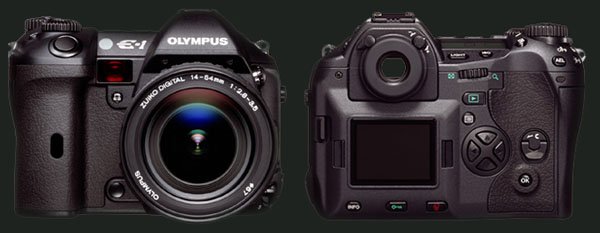
 |
Olympus E-1 Preview |
| August 21, 2003 |
| E-1 Preview • E-1 Preview (continued) • E-1 Preview (continued) • E-1 Specifications
|
Olympus debuted their E-1 on June 24th, 2003. After two years of hinting and talking about a new system, it finally appeared. Oly fans rejoiced. The extremely long wait, had finally come to a close, and Oly fans had a DSLR they could talk about. The Preview The E-1 is Olympus' response to the professional realm of DSLRs. In fact, the lenses made for the E-1, are digital Zuiko lenses. For those who are not familiar with Zuiko lenses, these are in the same league as Leica lenses, and they are not cheap. Olympus has made some bold statements about their E-1, and the E-System in general. Olympus claims that their E-System is "...built from the ground up to be digital and to be 'professional' in every sense of the word." These statements didn't have any way of being reinforced or validated, until recently, when samples were released on DPReview. Overall, I was impressed with the samples. The E-1 reminded me of my E-10's color--not too saturated, accurate, and vivid representations of what I saw when I clicked the shutter. One problem that has plagued Olympus with their E-series cameras, is noise at relatively low ISO levels. Many were hoping that the E-1 would breakaway from this, however, there were a few problems at ISO 800 and higher. UPDATE (November 29, 2003): Phil Askey has updated his E-1 samples gallery due to a newer production camera. Noise levels do appear to be lower than from its earlier version. The E-1's body is made from magnesium alloy metal, which is found in many professional DSLRs. This kind of construction allows for a lighter body, yet still retaining durability. The E-1 is also made of an "all-weather construction", making it resistant to water and other environmental conditions. Why only a 5MP DSLR? A lot of Oly users expected the E-1 to be at least 6MP and probably more. Currently, entry-level DSLRs start at 6MP, and $2K DSLRs with 8MP are said to be hitting the market in early 2004 (the D200 for example, which is expected to be 8MP1). So, why did Olympus decide to stick with a 5MP size that is a few years old behind other DSLRs? I will be the first to say: the more megapixels, the better. Now, what I am talking about, is crop potential. Megapixels are not to be the exclusive rule when buying a DSLR, but having a larger crop potential, is very beneficial. I will also be the first to say, most people won't notice this feature, and 8x10 prints are the majority of what photographers have coming out of their printers. A 5MP DSLR will be more than sufficient for 8x10 prints, and larger prints could be made without too much of a problem. We should also remember that Nikon just recently (July 22, 2003) released a 4MP DSLR (D2h) designed for sports photographers. Canon's 1D has been around for a few years, and it is 4MP as well. Nikon's D1x is 5.74MP, and the D1h is 2.74MP. It would be nice if the E-1 was a 6MP or even larger DSLR, but who knows what Olympus might release in the future. The E-1 is a first-generation professional DSLR, and it will be the litmus test of the Olympus professional E-System. The Buffer This is one of the E-1's strongpoints. It can do 3 frames-per-second, up to 12 frames (RAW, JPEG, or RAW + JPEG). Not bad at all. A D100 can only do about 7 frames, and a 10D (and the former D60) can shoot continuous up to 9 frames. The E-1 takes the cake in the buffer department with respect to these cameras. The D1x with an upgraded RAM chip (this upgrade was announced in October 2002), can shoot 3fps and up to 19 frames (JPEG; 14 frames NEF). Nikon's "h" series is a specific camera for a specific purpose, so an E-1 being compared with it, should not be exclusive. If Olympus comes out with a professional Sports-Only shooter (i.e., E-1h, then rest assured, I will compare them). The D1x without a RAM upgrade, can only shoot 9 JPEGs, and 6 NEFs (RAW) in a continuous burst. The Canon 1Ds can shoot 3fps with a burst rate of 10 frames (in any mode). Currently, this camera is in a class of its own, as it is an 11MP Full-Frame DSLR. Clearly, the E-1 holds its own, and I would have no problems shooting with it. Is the E-1 a professional DSLR? This is a controversial area. Olympus makes it clear it is a professional DSLR. No doubt about it. 3fps is currently the standard for a professional DSLR. The D1x, 1Ds, D100, 10D, all hover around 3fps. Some want to compare it with the D1x and Canon 1Ds. Comparing it with a D1x would be fine, but with a 1Ds, I'm not so sure. The 1Ds is in a category unto itself (at least until another Full-Frame DSLR comes out). 1As of March 10, 2004, Nikon has still to announce any DSLR over 6MP. |